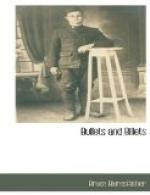This attic, as I have said before, had all one end blown away, but the two sloping thatched sides remained. I cut a hole in one of these with my pocket-knife, and thus obtained a view of the German trenches without committing the error of looking out through the blown-out end, which would have clearly shown an observer that the house was occupied. Looking out through the slit I had made I obtained a panoramic view, more or less, of the German trenches and our own. The view, in short, was this: One saw the backs of our own trenches, then the “No man’s land” space of ground, and beyond that again the front of the German trenches. This is best explained by the sketch map which I give on the opposite page. I saw exactly how the house stood with regard to the position, and also noticed that it had two dangerous sides, i.e., two sides which faced the Germans, as our position formed two sides of a triangle.
[Illustration: clogs and bucket]
I then proceeded to explore the house. In the walls I found a great many bullets which had stuck in between the bricks of the solitary chimney or imbedded themselves in the woodwork of the door or supporting posts at the corners. Amongst the straw in the attic I found a typical selection of pathetic little trifles: two pairs of very tiny clogs, evidently belonging to some child about four or five years old, one or two old and battered hats, and a quantity of spinning material and instruments. I have the small clogs at my home now, the only souvenir I have of that house at St. Yvon, which I have since learnt is no more, the Germans having reduced it to a powdered up mound of brick-dust and charred straw. Outside, and lying all around, were a miscellaneous collection of goods. Half a sewing machine, a gaudy cheap metal clock, a sort of mangle with strange wooden blades (which I subsequently cut off to make shelves with), and a host of other dirty, rain-soaked odds and ends.
[Illustration: map of village]
Having concluded my examination I crept out back to the wood and took a look at it all from there. “Yes,” I thought to myself, “it’s all very nice, but, by Gad, we’ll have to look out that they don’t see us, and get to think we’re in this village, or they’ll give us a warm time.” It had gone very much against my thought-out views on trench warfare, coming to this house at all, for I had learnt by the experiences of others that the best maxim to remember was “Don’t live in a house.”




